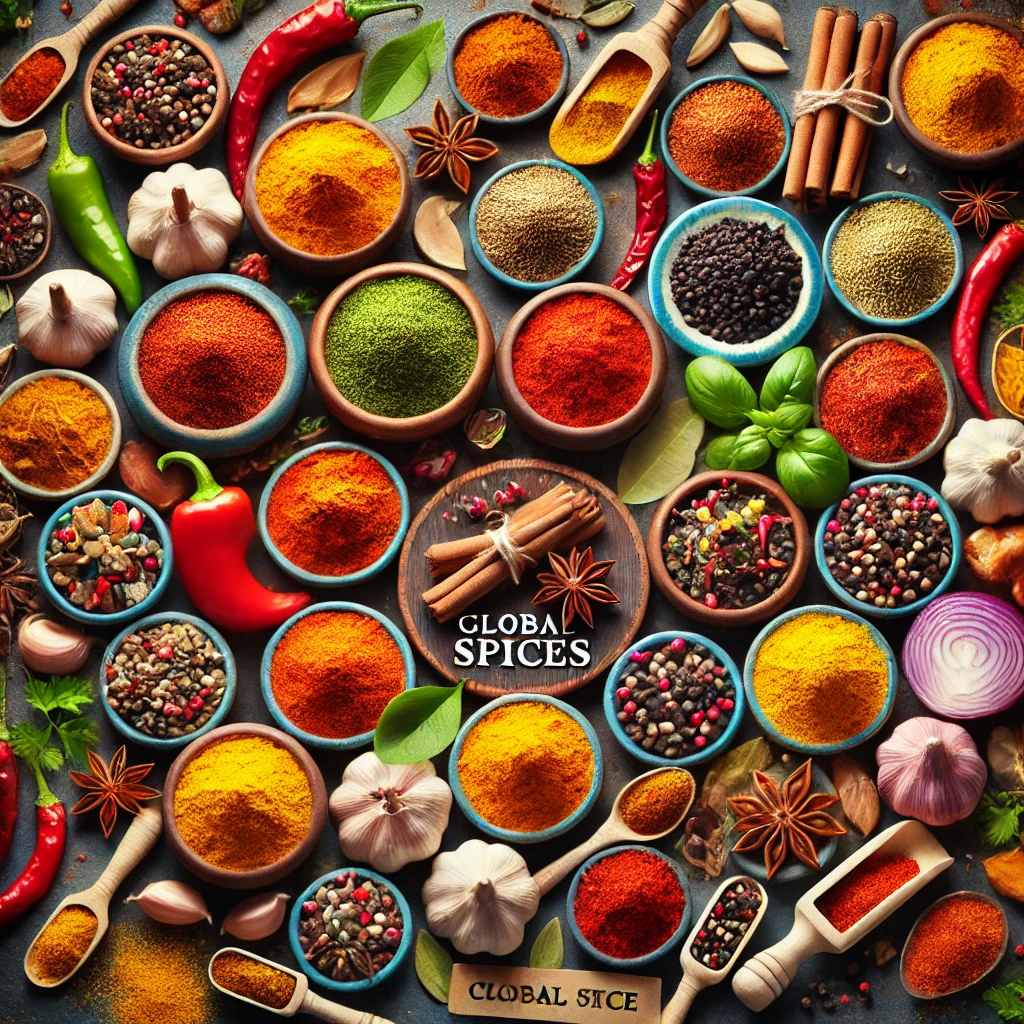For millennia, spices have played a crucial role in both culinary and medicinal practices. They bring unique tastes, vibrant hues, and complexity to dishes worldwide, turning ordinary meals into aromatic delights. Beyond their culinary uses, spices boast numerous health advantages, being recognized for their antioxidant, anti-inflammatory, and digestive properties. Their impact is evident across cultures, linking diverse culinary traditions through their distinct flavors and health-promoting qualities.
This article delves into some key spices used globally, their flavor characteristics, and the health benefits they offer, showcasing how these ingredients have influenced culinary practices around the world.
The Flavor Profiles of Spices
Every spice carries its own unique flavor, from sweet and warming to spicy and pungent. Mastering these profiles can elevate your cooking, allowing you to create dishes with authentic global flavors. Below are some popular spices and the cuisines where they are frequently used:
1. Cinnamon (Sweet and Warm)
Flavor Profile:
Sweet, warm, with a hint of woodiness and fragrance.
Popular Uses:
Cinnamon is prevalent in both savory and sweet recipes. It’s essential in Middle Eastern and Indian cuisines, often found in curries, stews, and rice dishes. In Western cooking, it’s used in desserts like pies, cookies, and pastries. Cinnamon enhances natural sweetness and is often paired with apples, chocolate, and nuts. It also features in blends like garam masala and Chinese five-spice powder.
2. Cumin (Earthy and Nutty)
Flavor Profile:
Earthy, nutty, with a slight bitterness.
Popular Uses:
Cumin is fundamental in Indian, Mexican, and Middle Eastern cooking. It’s a key component in spice mixes like curry powder, chili powder, and harissa. Cumin adds depth to meats, beans, and stews. In Mexican dishes, it’s used in chili and tacos, and in Indian cuisine, it appears in curries, dals, and tandoori dishes.
3. Turmeric (Bitter and Earthy)
Flavor Profile:
Slightly bitter, earthy, peppery, with a touch of ginger.
Popular Uses:
Known for its bright yellow color, turmeric is widely used in Indian, Southeast Asian, and Middle Eastern dishes. It’s commonly added to curry powders, soups, and rice dishes. Turmeric’s earthy taste enhances curries, lentils, and roasted vegetables. It’s also popular in health drinks, teas, and “golden milk” due to its anti-inflammatory benefits.
4. Paprika (Sweet and Smoky)
Flavor Profile:
Sweet, smoky, slightly peppery, with mild heat.
Popular Uses:
Paprika is essential in Spanish, Hungarian, and Middle Eastern cuisines. It’s key in dishes like paella, goulash, and chorizo. Paprika adds flavor to meats, stews, and vegetables, contributing both color and mild heat. Smoked paprika, common in Spanish cooking, imparts a rich smoky flavor.
5. Cardamom (Sweet and Citrusy)
Flavor Profile:
Sweet, citrusy, slightly minty, and floral.
Popular Uses:
Cardamom is widely used in Indian, Middle Eastern, and Scandinavian cuisines. It flavors savory dishes like curries and biryanis, as well as sweet treats like chai tea and pastries. Cardamom brings warmth and depth, making it popular in blends like garam masala and chai masala. It pairs well with coffee, citrus, and chocolate.
6. Ginger (Peppery and Sweet)
Flavor Profile:
Spicy, peppery, warm, with a hint of sweetness.
Popular Uses:
Fresh and dried ginger are staples in Asian, Indian, and Caribbean cooking. It’s used in stir-fries, curries, sauces, and baked goods. Ginger’s peppery warmth enhances both savory and sweet dishes, from spicy Thai curries to gingerbread cookies.
Health Benefits of Common Spices
Not only do spices add flavor to dishes, but they also offer numerous health benefits. Many spices are rich in bioactive compounds with properties that boost health. Here are some important health advantages linked to frequently used spices:
Anti-Inflammatory and Antioxidant Properties
Certain spices, such as turmeric, ginger, and cinnamon, are known for their strong anti-inflammatory and antioxidant effects, helping to reduce inflammation in the body.
- Turmeric: Curcumin, the key compound in turmeric, is known for its anti-inflammatory and antioxidant capabilities, potentially improving joint health and alleviating arthritis symptoms.
- Ginger: Gingerol, found in ginger, has anti-inflammatory qualities that can lessen muscle pain, nausea, and digestive problems.
- Cinnamon: Cinnamaldehyde in cinnamon offers anti-inflammatory benefits and helps lower oxidative stress, which may reduce the risk of chronic illnesses.
Digestive Health
Spices like cumin, fennel, and coriander are often used to improve digestion and promote a healthy gut.
- Cumin: This spice aids digestion by stimulating digestive enzymes and reducing bloating and discomfort.
- Fennel: Anethole in fennel seeds calms the digestive tract, helping to reduce bloating, gas, and discomfort.
- Coriander: Known to enhance digestion and alleviate indigestion, coriander is frequently used in herbal treatments for stomach upsets.
Immune-Boosting Effects
Several spices are rich in vitamins, minerals, and antioxidants that support the immune system.
- Garlic: With antimicrobial and antiviral properties, garlic is used to enhance the immune system and lessen the severity of colds and infections.
- Black Pepper: Piperine in black pepper boosts the absorption of nutrients, including those that support the immune system.
- Cloves: High in antioxidants, cloves contain compounds that combat bacterial infections.
Blood Sugar Regulation
Spices like cinnamon, fenugreek, and ginger may help manage blood sugar levels.
- Cinnamon: This spice improves insulin sensitivity and lowers blood sugar levels, beneficial for those with type 2 diabetes.
- Fenugreek: Fenugreek seeds, rich in soluble fiber, slow down the digestion of carbohydrates, aiding blood sugar control.
- Ginger: Ginger has been shown to improve fasting blood sugar levels and reduce the risk of complications from high blood sugar.
Heart Health
Spices such as garlic, cardamom, and turmeric can support heart health by lowering cholesterol, enhancing blood circulation, and reducing blood pressure.
- Garlic: Known to decrease cholesterol levels and blood pressure, thereby reducing the risk of heart disease.
- Cardamom: This spice can lower blood pressure and improve heart health due to its diuretic and antioxidant properties.
- Turmeric: Curcumin in turmeric may help lower the risk of heart disease by reducing inflammation and oxidative stress.
How Spices Define Regional Cuisines
Spices are key to the distinct flavors of various regional cuisines. Here’s a look at how some of the world’s most famous cuisines are characterized by their unique spices:
Indian Cuisine
Indian dishes are famous for their extensive use of spices, often blended into complex mixtures like garam masala, curry powder, and chai masala. Common spices include cumin, coriander, turmeric, and cardamom. These spices create rich, aromatic flavors that balance sweet, savory, and spicy notes.
Mexican Cuisine
Mexican cooking prominently features spices such as cumin, oregano, chili powder, and cinnamon, contributing to its bold and vibrant flavors.
By understanding the health benefits and culinary significance of spices, we can better appreciate their role in both our diet and global cuisine. ## The Role of Spices in Mexican Cuisine Mexican dishes like mole, tacos, and enchiladas gain their heat, smokiness, and depth from a variety of spices. When combined with fresh elements like lime, cilantro, and tomatoes, these spices give Mexican food its unique and bold taste.
Middle Eastern Cuisine
Middle Eastern food is known for its use of warm, earthy spices such as cinnamon, sumac, cardamom, and za’atar. These spices often appear in rice dishes, stews, and baked items. They strike a balance between sweetness and warmth, creating a rich, comforting flavor.
Thai Cuisine
Thai cooking is a balance of sweet, sour, spicy, and salty flavors, featuring spices like chili, lemongrass, galangal, and turmeric. Essential in curries, soups, and sauces, these spices, combined with fresh herbs, produce lively and flavorful dishes.
Tips for Using Spices in Cooking
Whether experienced or new to cooking, using spices well can change your dishes. Here are some suggestions:
- Use Whole Spices: Whole spices keep their flavor longer than ground ones. Lightly toast them before grinding to release oils and enhance aroma.
- Layer Flavors: For complex dishes, add spices at various stages. Start with base spices and add more as the dish cooks for depth.
- Pair Spices with Foods: Certain spices go better with specific ingredients. Cinnamon pairs well with sweet items like apples and chocolate, while cumin suits savory dishes with beans, meats, and vegetables.
- Proper Storage: Keep spices in a cool, dry place away from sunlight. Use airtight containers to preserve flavor.
Conclusion: The Impact of Spices on Global Cuisine
Spices are essential in defining the flavors and aromas of dishes worldwide. They also offer health benefits, aiding digestion and boosting immunity. By understanding spices, we can create varied and delicious meals that also support our health.
Including spices in our meals lets us enjoy the variety of global cuisines and appreciate their cultural significance. Whether using cumin in Mexican chili, cinnamon in a Middle Eastern dessert, or turmeric in an Indian curry, spices enhance our cooking and connect us to culinary traditions across the world.







Leave a Reply